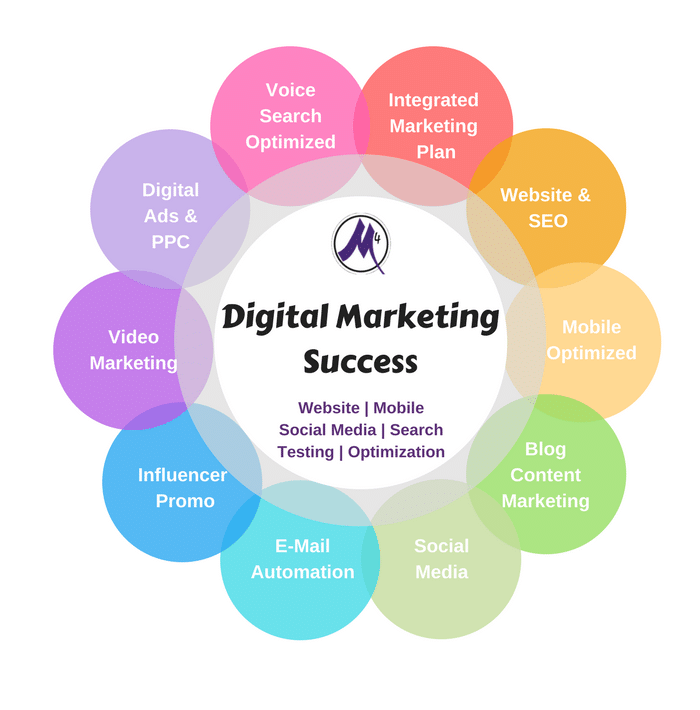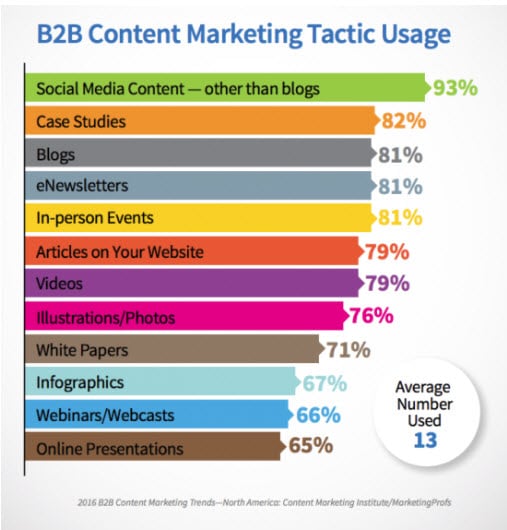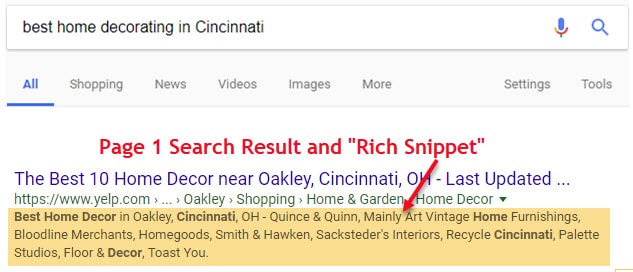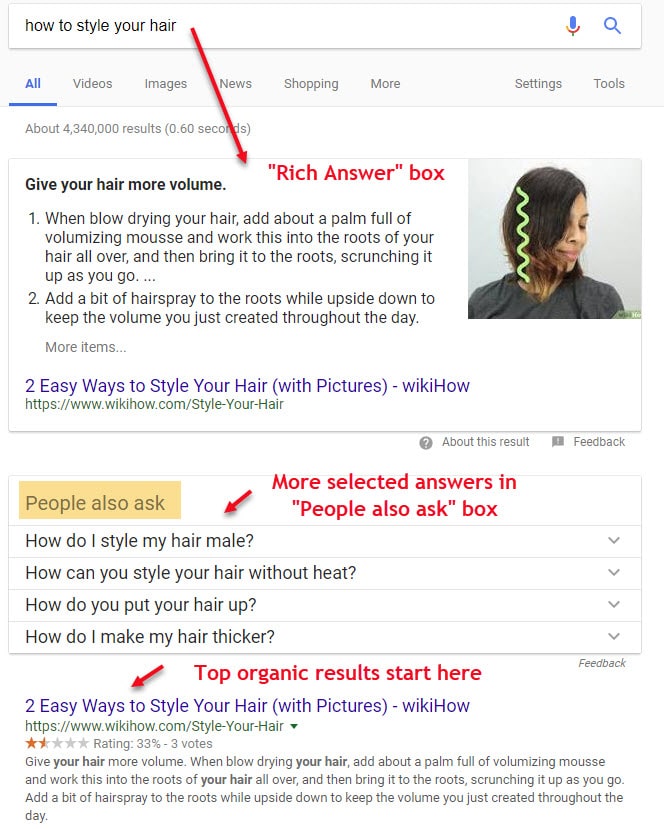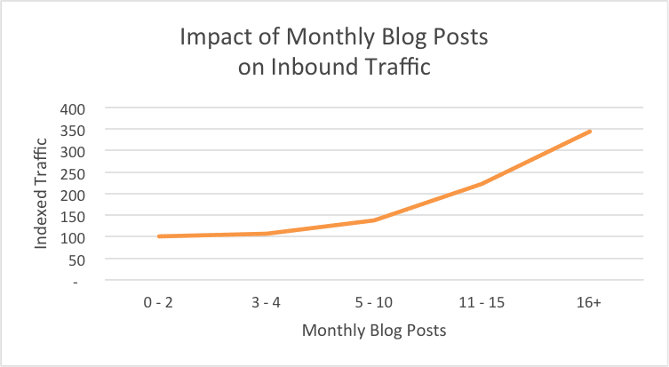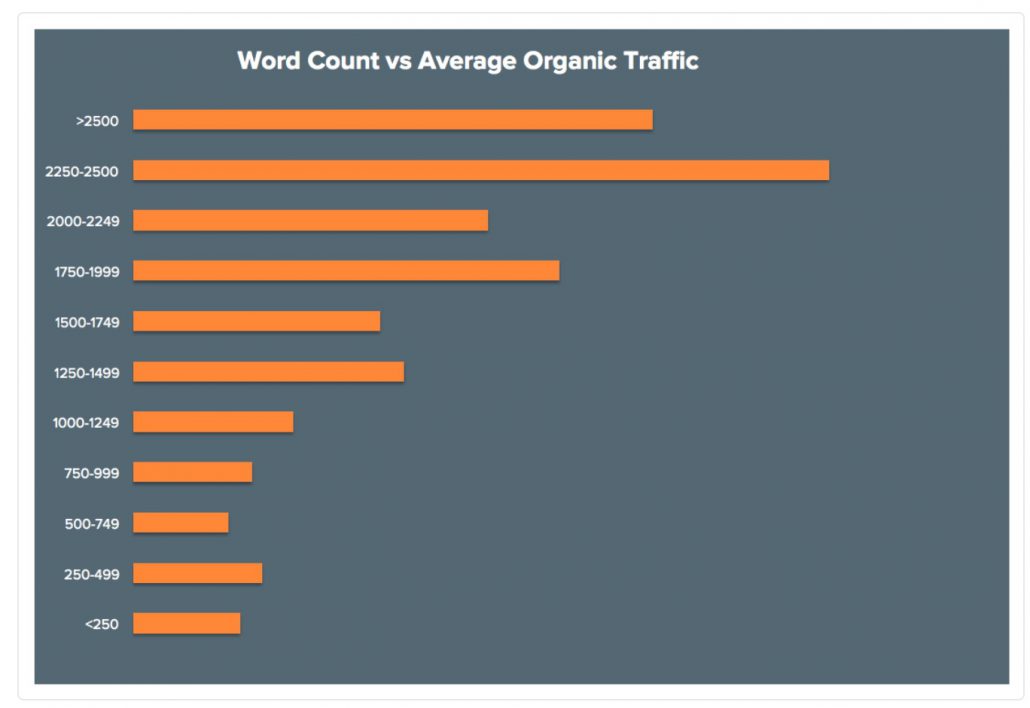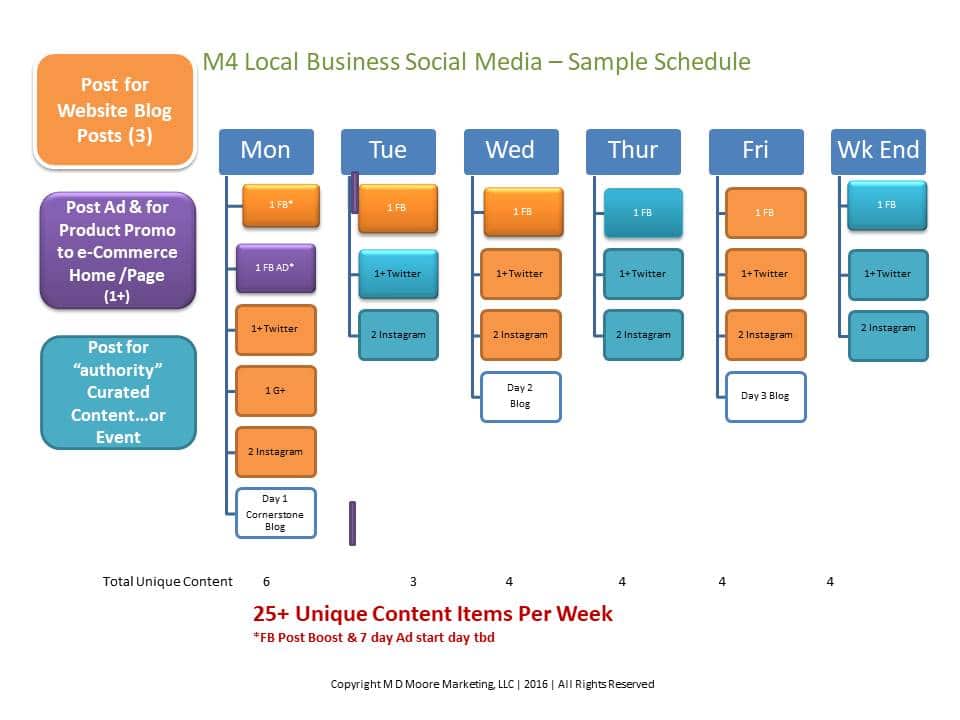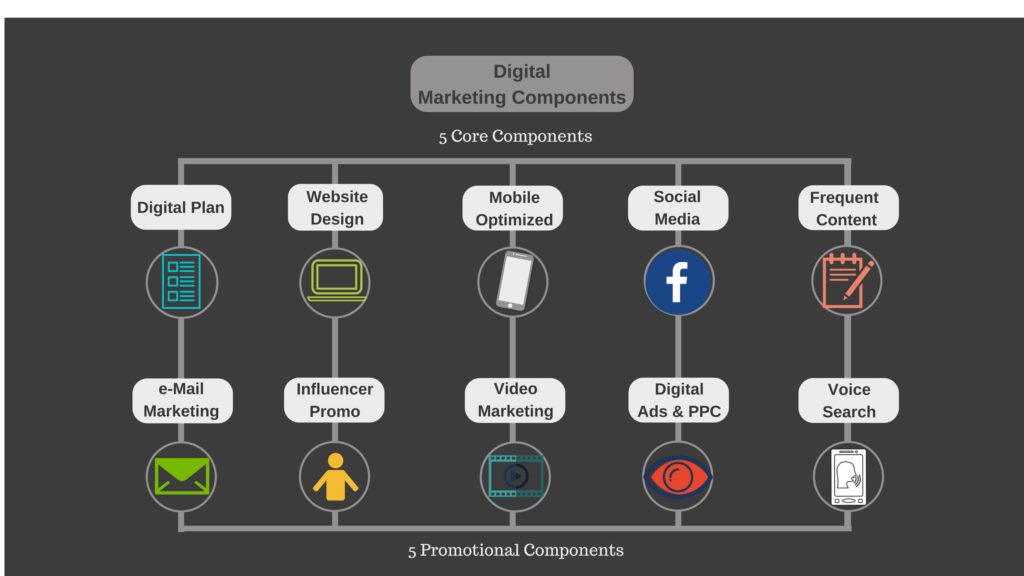8 Steps for Local Business Digital Marketing
The Local Business Dilemma – Competing in a Digital World
Small and mid-size businesses face many challenges to growth, limited resources, budget constraints, competition, staffing challenges, attracting and retaining customers. Adapting full range of local business digital marketing techniques will change the game for small local business.
Table of Contents:
- Review the latest Algorithm Changes for Facebook Marketing
- Sample – Local Business Weekly Digital Marketing Weekly Activities
- Self Assessment Quiz – Digital Marketing Implementation
Why Digital Marketing for Local Companies?
IMPORTANT! Let me first introduce you to “Moz”. This is a digital marketing company that is considered to be the top resource for information, studies and software for successful digital marketing…the very top authority in the digital marketing space.
Here is what they say about local business digital marketing:
Why digital Marketing for small and mid-size local companies?
Relying on experience and research, we have concluded that a local business is ideally suited to benefit from the technology and strategies of digital marketing. The information that follows supports this position.
Every local small and mid-size business needs to know today’s facts…
* SOURCE: NEILPATEL.COM / FROM STUDY BY : JOOPCRIJK.COM
Local digital marketing connects to where your customers reside and want to interact. This type of online marketing represents the integration of technology and relationship building in a totally unique way.
Digital Marketing current trends for local business growth highlight the dynamic capacity for small and mid-size local business to significantly impact growth. The opportunity to compete, and provide outstanding customer service, are reachable through digital marketing strategies.
Digital marketing can give the local business unprecedented access to customers.
According to Forrester Research, by 2020 over 42% of in-store sales will result from customers influenced by online research.
Where Today’s Customers Find Products and Service
Today’s customers are no longer tuning to traditional advertising channels such as newspaper, yellow pages and printed ads.
Here is a valuable short video to overview the local business concept by Neil Patel, international digital marketing authority.
Prefer to read? You’ll find a full transcript of the video below (bottom of page)…Enjoy!
Your small business customers are consistently connected to all things digital for product & service information…smart phones, tablets and computers.
We live in a mobile phone and digitally connected world.
Small and Mid-size local businesses face huge challenges as it related to marketing their products and services. The facts are that the internet and social media have change they way people search for and connect to local businesses.
Step # 1: What is Local Digital Marketing for Businesses?
Here is what you need to know in 2018 and beyond…
The term “digital marketing” is a broad description that includes the use of website design, social media, online advertising, email client building, search engine optimization mobile phones and much, much more.
This Chart of the 10 Key Components for a Local Business Digital Marketing Plan shows the Integration of Key elements.
The components as you can see include; Website Design and search engine optimization, Mobile Optimization, Content Marketing, Social Media Marketing, E-Mail automation, Influencer Promotion, Video Marketing, Digital Advertising and Voice Search Optimization.
Step #2: Understanding the Components of Local Business Digital Marketing
Let’s look at a clear summary of some of the core elements and relate it to a local business competing in their market area.
Integrated Marketing Plan
Most successful businesses understand the importance of a Plan for their business which usually focuses on such things as budgets, sales and advertising, employee and service, etc.
Local small and mid-size businesses need a comprehensive digital marketing plan and strategy as well. This is not something you can dabble in or work bits of it around the edges.
Review the 5 Core Components of Local Business Digital Marketing
Let’s take a closer look at 5 of the Fundamental Components, to get an understanding of these foundation elements for building a successful Plan
A Digital Marketing Plan
A digital plan is equally important, as part of your over-all Business Plan, and integrates the 10 components. These components need to be tailored to the needs, customers and competition in the local market place and dialed into the needs, time and budgets of the business.
The Digital Marketing Plan also includes a very important component “Strategy”, particularly for local SEO and digital marketing
Michael Porter, famed Harvard professor and best-selling author, has been dubbed “the father of modern business strategy.” He defines strategy as, “Performing different activities from rivals’ or performing similar activities in different ways.” A marketing strategy is a set of different activities that attracts and keeps customers (clients).”
“ATTENTION LOCAL BUSINESS!” Keeping up with competitors, let alone out marketing them, requires the active implementation of different or better marketing than your rivals. A Digital Marketing Plan, custom tailored to your business can be that “different activity.”
Step #3: Pivotal Importance of a Local Business Website
The vast majority of local companies, just over 71%, have some form of website, but over one quarter of small businesses do not have a website today.
- 60% of all small-business do not have a truly mobile friendly website, yet 82% of Mobile users search for a local business online.
- 93% of small business websites do not display a Contact e-mail address, and 49% do not list any phone number,
- 85% do not use any analytics or tracking tools to measure success.
Consider the local business website as the “Mother Ship” of your 10 Component digital marketing plan
Can customers find Your business in an online search?
Maybe Not!
Over 26 percent of small businesses cannot be located in an online search by potential customers due to not having visible ranking in the search engines. You will find that most others are not on the first page, top 10 results, in a local Google search query.
The primary objective of successful digital marketing is to drive traffic to your website. Your business must be visible in a mobile or website search.
You must have a fully functional “digital marketing designed” business website. That said, most local businesses are unaware of the difference between a website and a digital marketing website design.
Far too many local business websites that do not have a “responsive design” allowing clear visuals and ease of navigation when viewed on mobile devices. This means website pages can look strange and difficult to navigate on mobile devices.
We are seeing over 40% of all client traffic coming from mobile devices and that number is likely to increase.
Your business website must not only look professional but must provide the visitor with easy to find content and simple navigation (called user interface).
Your business “NAP” (name, address, phone) must be clear and shown on every Page and Post. The Phone number should be “clickable” for mobile devices…and it must appear exactly the same everywhere on your website and the same when used in adverting.
The absolute objective of your business website is to directly and indirectly help to get visitors to Call, Subscribe to your E-Mail or walk into your store or business location.
To attract visitors and get your website pages ranked in the search engines it must be mobile friendly, easy to navigate and contain fresh and customer focused content.
5 Key Benefits of a Website
As the world continues to become more and more digital, the benefits of a website are hard to ignore. Experts point to five major opportunities websites can provide small businesses:
5 Key Benefits of a Digital Optimized Website and Local SEO
- Increased leads and sales.
- Promotes your “Brand” and visibility.
- Digital strategies and advertising are cost effective and results easily tracked.
- Provide a “Customer Service” and relationship building platform.
- The Ability to target marketing to your specific audience.
Step #4: Social Media Channels and Digital Marketing
The effects of search engine ranking by using social media is an evolving discussion. Here are the direct and indirect ranking factors with Social Media channels
- Social media posting can create “Links” to your website which is a high ranking signal
- Purposeful social media posting can build your authority & promote brand which is a ranking signal
- Content you post that gets mentions on other blogs and social profiles is a ranking signal
- Bing Channel (33% market share): uses “social authority” , and how many people Follow our channel as a ranking signal
Facebook is the largest source of business leads in the world. In the U.S., only 45% of small businesses use Facebook vs 85% of Larger Businesses (Ref. Leadsrecon).
Social Media marketing creates a lot of questions for most local businesses. It can be confusing to determine which social media channels (Facebook, Twitter, Instagram, etc.) to spend time on, how often to post content and what kind of contact is best.
Successful marketing with Social Media is based on a clear understanding of your customer base.
Frankly, most businesses think they have the answers but in many cases they do not.
Of course, a successful business has knowledge of their customers but not a deep dive into what the customers really want and need. If they did, and reflected that in their social media, their conversions, followers and leads would be higher.
Almost every local business we talk to is trying to leverage social media in some way but have no real measurement of how its working to create sales and new customers. This leaves them blind as to what changes to make to get better results.
Trying to market with social media can be a huge drain on a business owners time and money unless they determine which channels are most used by their customers, are relevant for their business and what content to post.
Think about it. Prospective customers are not looking for an electrician on Pinterest or an accountant on Instagram…not happening!
Social media first and foremost is a way to enhance relationship with current and prospective customers, provide best-of-class customer service and deliver ideas and helpful knowledge of interest to your market niche. Most of the time it is done wrong.
Mobile Optimized
Previously we pointed out the importance of a website being optimized for Mobile use. The high percentage of people who use their mobile devises to find products and services in their local markets is undeniable.
Small and mid-size local companies have the most to gain by mobile optimization.
There is another critical reason for optimizing for mobile viewing…search engine Ranking
If , for example, you are a local business owner offering custom kitchen cabinets, when a prospective customer does a Google Search for “custom cabinets near me” or “custom cabinets in (your city)” you absolutely want your business to appear on the first page of a Google search.
There are many components required to get your website and important website Pages ranked on the first page of the search engines.
One of the most important is “mobile optimization.” Google particularly indexes your website for how well it is optimized for viewing and speed on mobile phones.
Poor optimization means lower ranking. It also means mobile phone users will click away in an instant if your website is difficult to see and navigate on their mobile device.
Step #5: E-Mail Marketing for Local business “Don’t Fall Asleep at the Wheel”
Some may think e-mail marketing is old school or out dated. Nothing could be further from the truth.
According to Campaign Monitor, “email marketing is the king of the marketing kingdom with a 4400% ROI and $44 for every $1 spent.”
Building a subscriber list, segmenting it between customers, interest, prospects etc. and implementing regualr e-mail campaigns is golden. E-mail is a small and mid-size business dream because it is affordable, easy to implement, effective at building and retaining customers.
As strong as social media can be in customer and product communication, the website posts we make are seen by a small fraction of visitors and followers, particularly on Facebook and Instagram (more on this later).
To reach more people the social media channels want you to advertise and this is where e-mail shines
Email marketing gets better results than social media in most cases, but only if applied the right way.
Step #6: Website and Social Media Content Marketing
Website Pages & Posts and Social Media Posting allow you to create customer centric information. Your articles and Post messages need to deliver two things…in this order:
- Valuable “content” that is engaging and on-point for your target customers
- Optimized for search engine and social media Page Rank.
Website Content Types for Online Marketing
Understanding the “types” of content that form the foundation of your website information and promotion allows a local business to determine their posting strategy.
In an article on Smart Insights, in a study done by the North American Content Institute, the following types were studied and ranked.
Based on our experience in local business marketing, we recommend the following 5 types as a base strategy for most businesses.
- Social Media Content Posting
- Blog and Website Articles
- Videos
- Infographics
- Customer Cases Studies and Testimonials
What is “Content Marketing”?
In the context of digital marketing for local companies, Curata defines it this way:
Why Implement consistent content marketing?
72% of marketers say relevant content creation was the most effective SEO tactic. (Source: Ascend 2015)
72% of consumers who did a local search visited a store within five miles. (Source: WordStream, 2016)
60% of marketers create at least one piece of content each day. (Source: eMarketer)
Content marketing costs 62% less than outbound marketing & generates 3x as many leads (Source: @demandmetric).
Implement “Rich Snippets”, “Rich Answers” and FAQs On Your Business Website
Use The term “Rich Snippets” refers to the information Google shows in a search regarding your website content. They apply to a wide variety of website Content types and are included in the search display with the normal information shown for an organic search.
A snippet is a result Google shows to the user in the search results. An example: I searched for “best home decorating in Cincinnati”
The use of “Rich Answers” is an important strategy but different from rich snippets.Like most people, you have probably typed a search question into Google to find out how something works or locate a service.
People are changing their behavior and expectations for how use Google. People want a search to provide quick and clear answers. No longer do people want to spend their time searching for answers or information More an more the prefer Google to quickly offer up answers to their questions.
Google has recognized this and introduced “rich answers” to its search algorithm, so they can provide more accurate results quickly. Different from “Rich Snippets”, which you can control with SEO techniques in your article content, Rich Answers are selected by Google’s algorithm from what they determine to be the best answer to the search question.
For example, If you search for “how to style your hair”, Google selects from among the website content that best answers the search question and provides that answer in the “Rich Answer” box and more relevant answers in the “People also ask” box.
Your opportunity to be selected for Rich Answers” by Google depends on how clearly, accurately and well your articles answer a particular searh. The benefit here is that even if you are not in the very top results for a search, your selection for the Rich Answers will have the effect of increasing your website traffic.
It would be smart to implement rich answers on your website so when people are asking Google these questions, your site may appear first.
Using Frequently Asked Questions (FAQ’s)
The use of FAQ’s in your sontent to answer the most important questions yuour potential customers might ask, is current strategy. To utilize FAQ for SEO requires xxx mark-up. Structured data is defineds as a “standardized format for providing information about a page and classifying the page content.” If your site uses the WordPress CMS, there are a number of software Plugins that can simplify the use of FAQ structured data implementation. Also, WordPress has added FAQ markup in their Block Editor.
This markup makes it super clear to Google what the FAQ is and if you provide a clear answer it may show up in the page search as FAQ.
In 2021 Google instituted a rule reagarding FAQ structure data that you will need to follow that limits a pages FAQ to two. Google limits FAQ rich results to a maximum of two per snippet. Read more here FAQ Limits.
Content that is “Voice Search Optimized” is a must
Your website pages and articles must be optimized for “voice search”. Today more and more people are using their mobile phones our stand alone voice activated home devices such as Amazon’s Echo for searches.
“40% of adults now use voice search once per day” according to Location World
(https://www.branded3.com/blog/locationworld-2016/)
It is clear from the studies and experience of the search engines that indicate that voice search is the future. In fact, ComScore predicts that “50% of all searches by 2020 will be voice searches.”
The search behavior of customers and prospects for local business is changing at an accelerated pace. Today, people are driven by two behaviors that must be accounted for in marketing and promoting a business:
- Convenience and easy access
- Low stress and effort
Technology has created an environment where people expect instant, easy answers when they search that are a clear answer to their questions. Nothing matches a verbal command in an online voice search.
This means that website Content must be optimized for keywords that represent the likely question someone would use to search with a voice activated search.
Step #7: Learn Why Local Business Falls Short of the Benefits of Digital Marketing
Small businesses that blog get 126% more lead growth than small businesses that do not blog (Source @impactbnd).
If you are feeling overwhelmed by the amount of content you’re competing against, you need to develop a strategy which focuses on your strengths and lets you win in your competitive niche by finding the best way to create quality content.
Look, every local business owner is is busy and does not have time to waste. That said, you have to make time or find resources for what is important to your growth.
The local markets are challenging and competitive. You need to make time for what is most important because “you are either going up or going down”..standing still is not an option.
A local business has to take control and focus on what matters…digital marketing today is what matters.
Step #8: Take a Candid Look at your Local Digital Marketing Status
Most local businesses have some form of social media marketing activity but have a difficult time staying current with the rapid changes in how to market on Social media.
Most have a business website but is it digital marketing ready, mobile optimized and delivering results?
Many businesses try to deliver some level of content on their websites and social media channels but do they get results? Implementing tracking and analytic is paramount to evaluate and make changes?
As a business owner you owe it to yourself to review where you stand today in your digital marketing efforts and to find affordable solutions to implement strategies that get results and compete.
Find out more by taking the quick Self-test Quiz below and review the example of changes in Facebook marketing.
Your local small or mid-size business or professional service practice has the capacity for significant growth in leads and client conversions with digital marketing strategies..
At this point, it is often easy to say ‘this makes sense but I am already busy and have a business website and use social media already‘.
Really?
Let’s take a look at the latest change to Facebook’s algorithm which determines what content gets shown.
Active on Social Media…Think Again…”Facebook Zero”
Are your Facebook posts in alignment with the Facebook Zero changes that will allow your posts to show up in the news feeds?
Here is a brief description of what is being referred to as “Facebook Zero” and why it matters.
Mark Zuckerberg and team announced that they are changing the Facebook algorithm and will henceforth . . .
“. . . prioritize posts that spark conversations and meaningful interactions between people. To do this, we will predict which posts you might want to interact with your friends about, and show these posts higher in feed. These are posts that inspire back-and-forth discussion in the comments and posts that you might want to share and react to—whether that’s a post from a friend seeking advice, a friend asking for recommendations for a trip, or a news article or video prompting lots of discussion.” Facebook’s responsibility is maximizing profits for shareholders, not maximizing YOUR profits.
>>>Read the complete article at Convince and Convert.
So, you think you have Social Media covered. If you use Facebook to increase your exposure, leads, sales, or traffic, then please review and answer the following questions.
Test “Where You Are in State of the Art Facebook Marketing”.
Facebook’s new Algorithm, called Facebook Zero, requires a local business to implement the following.
1. Facebook Zero results in prioritizing posts that “spark conversations and meaningful interaction among people.” This does not refer to “Likes”, “Shares” or even “Comments” in general. It suggests generating comments of a minimum length (supporting real engagement) and the active replies to those comments.
2. User-generated Content (UGC) , which means generating posts from real people. These posts will take priority over promotional brand posting. To achieve this you need to encourage and motivate customers and employees to post on their own Facebook Personal pages mentioning your local business.
[ ] Do you have an active program to encourage customers and employees to post about your business?
3. Facebook has indicated their new algorithm will give “extra credit” to content that attracts “word of mouth interactions”. Several techniques that help in this area would be Videos (particularly “Live” video) on “how to do” things, FAQ’s, Q&A, etc.
[ ] Are you posting videos that provide help and solutions to common issues your customers are dealing with today?
4. Live Video. According to Convince & Convert.Com recorded video will be (devalued) a bit in favor of Live Video.” FB has communicated that if you use Live Video it may achieve as much as 600% more interactions than regular video type posts.”
[ ] Do you have plans to post Live Video?
5. Your Facebook Marketing Plan should involve creating a “Facebook Show”. We know the new Facebook Zero algorithm will prioritize & promote your brand content in New-feeds if you create conversations that engage people.
Engagement also means anticipation. Your target audience needs to know when your valuable and interesting content is actually coming. Small and mid-size local business would benefit by creating their own “Facebook show” with interesting content, posted regularly such as every Friday at 7:00 PM.
[ ] Do you have plans to regularly post a Facebook Show?
6. The Leverage of Facebook Groups. Creating a Facebook Group for you business is a method of engagement that goes beyond simply posting to your Page. Studies show that content created within the Group results in performing better than regular News feed posting. Setting up a Facebook Group around your businesses target market for your customers, potential leads and your own employees, is easy to start and test.
[ ] Have you created a Facebook Group for your business?
7. Facebook Messenger. It is very clear right now that Facebook wants to take over the “person-to-person messaging” and interpersonal communication space. The rapid growth of Facebook Messenger is due to avoiding the clutter in your FB inbox and for your local company it creates a platform for multimedia.
[ ] Are you using Messenger and creating Messenger Bots?
If you create a FB messenger Bot (a software application that can execute commands, reply to messages, or perform routine tasks to help deliver quality content and interaction) the “response rate is much higher” than regular e-mail and your business news-feed.
These elements, resulting from the new Facebook algorithm, are about the organic (free) reach for your business Pages. The slightly veiled efforts by some to use “click bate” content to increase their brands awareness will be “punished” by these changes.
OUT RANK THE COMPETITION WITH DIGITAL MARKETING!
The 3 most important best practices for local business digital marketing relate to these strategies:
- How many times should you post articles to your website?
- How long should your articles be for ranking?
- How many times should you post to your selected Social Media accounts?
Let’s look at the latest facts of these three questions.
How Many Website Posts Should Be made each Week?
The frequency of website content posting, to provide the opportunity for increasing traffic and ranking, will most certainly vary with the type of business and the target market. That said, the data suggests the following according to Blog Spot’s ongoing research.
Overall
As expected, we found that the more blog posts companies published per month, the more traffic they saw on their website. Companies that published 16+ blog posts per month got almost 3.5X more traffic than companies that published between 0 – 4 monthly posts.
Here is what this looks like:
Source: Blog Spot.com
As a starting point for a local company wanting to generate more traffic and increase the opportunity for ranking, 16 website posts a month would be a best practice to follow.
This means averaging at least 3 or more per week.
How Long Should Article Content be for Ranking and Engagement?
The length of a website article has been the subject of many studies and much discussion. The experienced digital marketing experts do not always agree and trying to layout the “perfect formula” for content length is not possible.
The type of business, the target customers, and your competition are all influencing factors on the type and length of website content.
First, let’s look at the broad studies that have been done to determine how articles of different length perform in Ranking in the search engines and creating website inbound traffic. Here is a reference from HubSpot.
So, since Content is so important to a local business ranking and traffic, how do you determine what your target should be for website article length?
Content Quality vs. Quantity
It is clear that posting 16+ website blog articles of pages a week is the best practice for creating traffic and potential ranking. This does Not mean content that is poor quality, that does not engage and provide value to visitors. We understand that creating 3+ quality articles a week of 1,750 words or more is very challenging for a small business.
This is why our system teaches the local business to spend their time and resources creating one “Pillar Post” per week instead of time spent on “high-frequency writing.” Then, create 2 more articles a week off of the Pillar Post with other types of post formats..This works!
The factors for determining the length of your Pillar Post is actually straight forward and involve three criteria,
#1 Article Topic: how much content and information are needed to communicate your topic and ideas in a clear, concise and complete way that informs and creates engagement?
#2 Article Keywords: Each article topic will have a primary Keyword it is targeting and this will be supported by selected secondary Keywords and Long-tail Keywords (relevant terms of 3 or more words in length).
These keywords are critical because they tell the search engines exactly what your article is about so the content can be indexed and ultimately ranked.
These are the Keywords that we determine to be what a potential customer would use to search for answers or information related to your article’s topic…content that best answers the search query.
Some Keywords used in your article will take more content to answer the query and others less content.
#3 Your Local Competition: when you enter your primary Keyword in a search, say a Google Search, take a close look at the Top 10 “organic” results (not Ads or Info & Promotion sites like Wikipedia, Yelp, Amazon etc.).
We are focused on your local competition. Looking particularly at the Top 5 competitors in the search results,
- How long (total article words) is the average of the Top 5? This is easy to do. Copy the article content and go to https://wordcounter.net/ and paste it in and you will get an instant word count.
- What are the primary and secondary Keywords used (look at the Headings & Sub-headings or highlighted words and phrases)?
- How well do you think these sights answered the “search query” (can you do a better job)?
Armed with this information, you can create an article to improve your ranking against the competition. You will strive to answer the “search query” in a better way, provide more complete coverage, new ideas, better images…AND A BIT LONGER.
Google will always try to rank and show the website articles that provide the most complete information that answers the “search query”. They do have a preference for complete coverage of the topic and length of the article is a ranking factor if the quality of the information is the best.
Our recommendation, based on our own experience and that of other local businesses, is to reference the Hub Spot Chart above. You will see that Content length between 1,750 and 2,450 rank higher as a range and generate the most traffic.
Use this and the 3 criteria above to determine the length objective for your article but at least 1,750 words in most cases to start. Then, over time, you use Google Analytics for your website and check Google Search Ranking to see which articles and lengths are getting the most traffic and highest rank, then adjust length accordingly.
How many Social Media Posts should you make for best results?
Since Social Media Marketing is such a key component of online marketing success, understanding how to leverage the channels for a given Local Business is critical.
The primary question here is “how often do I post content to social media to take full advantage of promoting my business and increasing leads, sales and brand awareness”?
Actually, the answer here is not too difficult.
Because most small and mid-size businesses have limited time and resources, the question is really ” what is the minimum number of posts I need to make to social media channels to get the best results?”
The most current and authoritative study on positing frequency is a study that includes “proven research from 14 separate studies” compiled by CoSchedule.com*
Here is a summary of these findings in terms of Posts per Day:
Facebook 1-2 (not counting Ads or Boosts)
Titter 2+
Pinterest 11 (80%, or 9 of 11, can be Re-pins from others)
Linkedin 1
Google+ 2
Instagram 1 – 2
Review our example below of a local business Social Media Posting schedule where it was determined the best channels for their customers, products/services and business would be Facebook, Twitter and Instagram and the minimum posting frequency.
This can seem rather daunting at first but there are techniques that make this a doable strategy.
These daily posts include selecting and posting other people’s authority content on social Media. This promotes your business as a source of the latest information . You can using semi-automatic posting software which allows you to schedule and post weekly content you create on your socail media channels.
Creating content for your website can also be facilitated by creating 1 Cornerstone article each week in the 1,750 – 2,250 range and then creating a shorter article from that article (such as a Q&A article) and then an Infographic (using free online software) or a Forum each week to discuss the ideas from the cornerstone article.
This results in getting 3 weekly website articles from one Cornerstone post.
Local Business Digital Marketing Quiz
As a Local Business, the only way to compete in your local market niche in the digital world, and top you local competition, is to become your customers and potential customers absolute favorite website blog, podcast, webinar educator, email help and support communicator.
Does this describe where your local business is today in your market?
We created a very short quiz to help small and mid-size local companies to determine where they are today in using real digital marketing. No trick questions…just a self-test covering the highlights of what is covered in this article.
Whatever you learned from the Quiz, a review of the following may benefit you greatly as a small business owner.
How to Implement Local Business Digital Marketing Best Practices
Typical Digital Marketing Weekly Activity Plan for Local Businesses
Once you have the 5 Core Components of a comprehensive Digital Marketing Plan set up and in place, the majority of your ongoing marketing efforts involve the creation, posting and tracking of:
- Website Articles and Blogs
- Social Media Posts
- Social Media Ads
- Tracking Results
In addition, you are trying to Rank your website Articles and Content on the 1st page of a local Google search and rank in the top 5 or better.
It is my found hope that this article has provided proof positive of the dynamic advantages of comprehensive digital marketing and online promotion for local small and mid-size companies.
At this point, it is very normal to feel over-whelmed and thinking ‘how can i hope to implement full-scale digital marketing for my local business?’ It can feel daunting. What will it cost? How much time will it take? What resources do I need?
Local business digital marketing services vary in scale and cost from market-to-market.
Typically, there have been three choices for local business.
1. Do it Yourself…but where will you get the skill and knowledge, let alone the time?
2. Outsource part of it…but which part and for what cost?
3. Outsource all 10 Elements of Local Digital Marketing…at what cost?
You can start by doing a Google search in your local market for digital marketing services, or SEO services, or Social Medial marketing services.
Now that you know what is involved you will be able to see, on the websites of companies that show up for various digital marketing services, what they provide. Costs may not be shown, so you may have to call to get pricing information.
Could there be a better way…an affordable way to implement a unique digital plan for your business?
It was this very question and problem that I faced 10 years ago when I got started my digital and online marketing efforts and subsequently found that small companies in our area were struggling with this as well.
This was the catalyst for the creation of “M4 Digital Marketing” services for local companies.
Over- 5 years of research and testing, we determined that there were four ways that could be used to help a local company implement true digital marketing tailored to their needs, time availability and budget..
1.Do-It-Yourself (DIY) with Training – by acquiring complete training and learning the basic skills. Learn how to implement the 5 Core Components by completing a thorough online training program and execute the plan yourself. Outsource elements of the 5 promotional components to M4 as needed at an affordable cost.
2. Collaborate on 5 Foundation Level Digital Marketing – Complete the M4 Foundation Training program and implement a specific set of tasks in about 4 to 6 hours a week (after training is completed) and have M4 Digital Marketing provide coaching and collaboration to jointly implement the 5 Core components. You can outsource the additional components of the 5 promotional components to M4 as needed at an affordable cost.
3. Collaborate on Full 10 Component Digital Marketing – Complete the Foundation Training program and implement a specific set of tasks in approximately 4-6 hours a week (after training is completed) and have M4 Digital Marketing provide implementation and consulting for the 5 Core balance and the 5 Promotional Components of comprehensive digital marketing.
10 Components of a Complete Local Digital marketing Plan
4. Full Service Digital Marketing – Outsource the creation and implementation of a comprehensive digital marketing plan to our organization. This includes a weekly conference call to review actions and results.
Conclusion – Local Business Digital Marketing
When a small and mid-size local business has a digital marketing plan, training and the tools and resources, the opportunity for business growth and competitiveness are reachable.
Here is what Michelle Bottomley, chief marketing officer for Staples said, “When small business owners feel they have the necessary tools, support and assets to thrive, they’re able to devote more time and attention to what they’re passionate about — providing their customers and clients with exceptional goods and services.”
We believe that our M4 Digital Marketing Program gives you the tools and training to do just that.
Putting in place a true local business digital marketing plan will take time and all the components and activities need to be organized. Check out our Digital Marketing Case
According to Small Business Trends, “75% of Struggling Small Business Owners Believe Being Disorganized Leads to Productivity Loss”
The purpose of this article was not to advertise our services but to educate local business owners about the state-of-the art in local digital marketing strategies and what is involved. Hopefully our article has accomplished that for you.
If you would wish to learn more about the M4 Digital Marketing Services, we invite you to start that conversation Here >>> business digital marketing
(*) Sources (Images – Quotes)
Local Marketing Studies:
http://joopcrijk.com/small-business-marketing-2/
https://neilpatel.com/blog/resurrect-local-seo/
Statistics
https://blog.hubspot.com/marketing/character-count-guide
https://blog.hubspot.com/marketing/blogging-frequency-benchmarks

